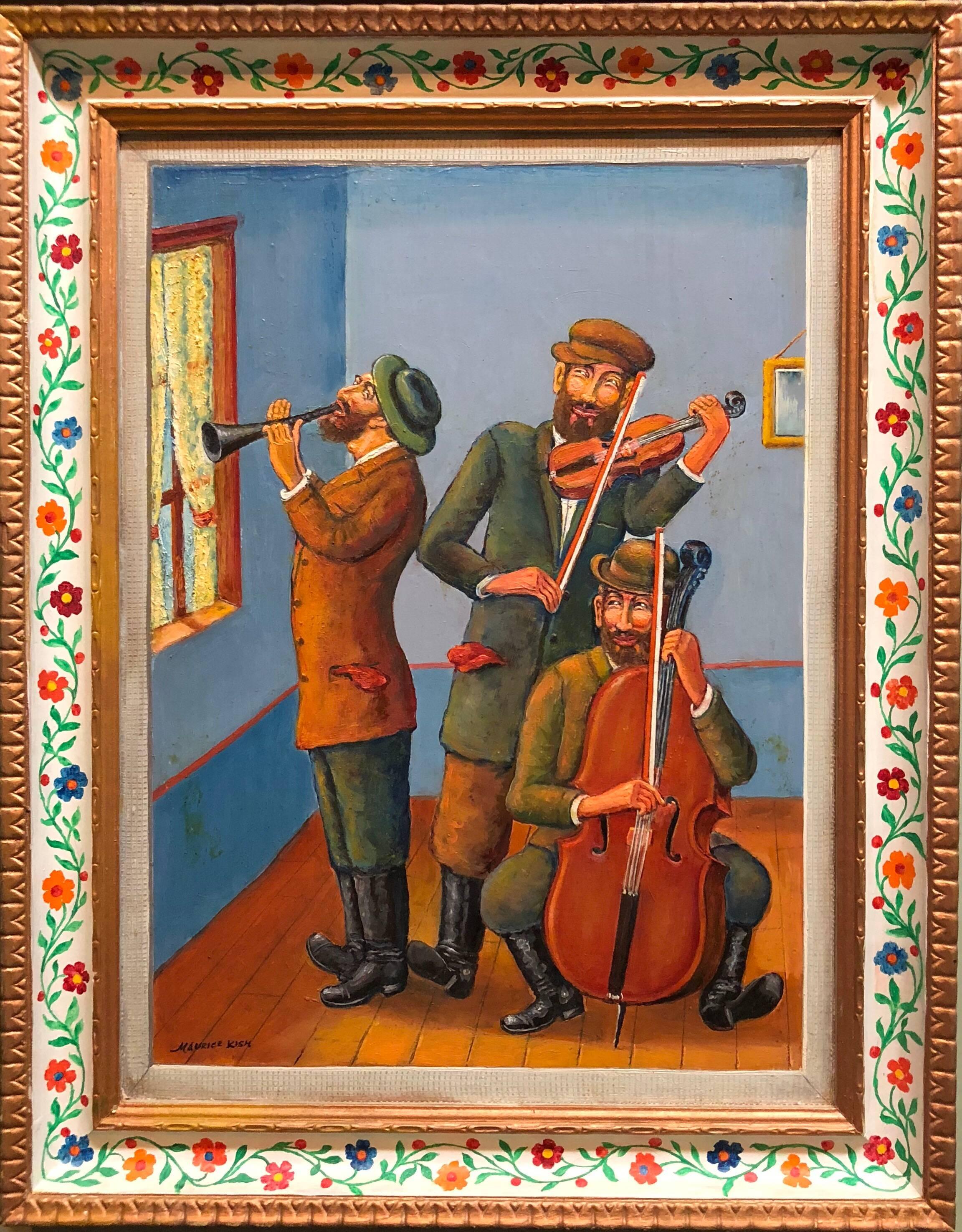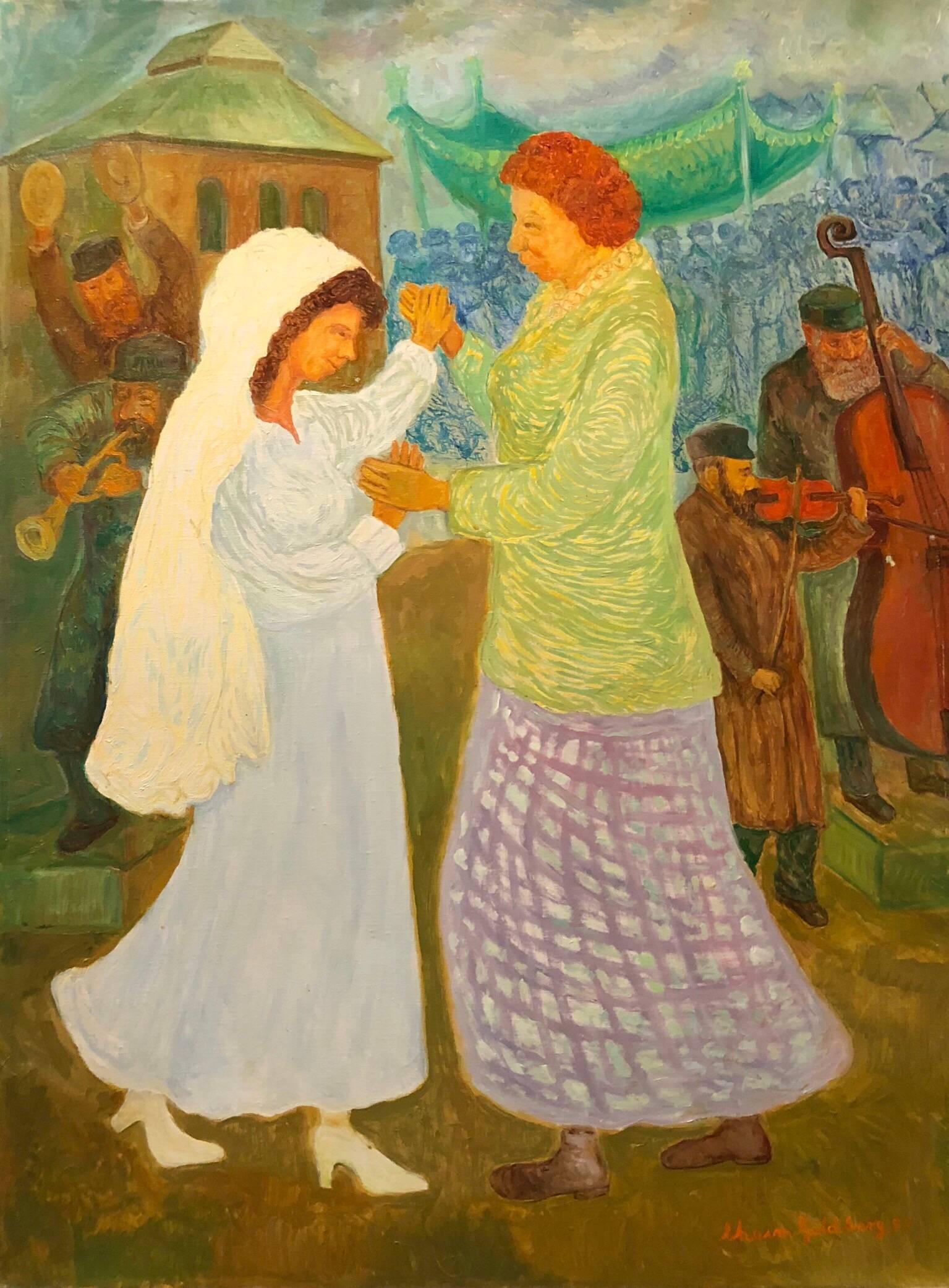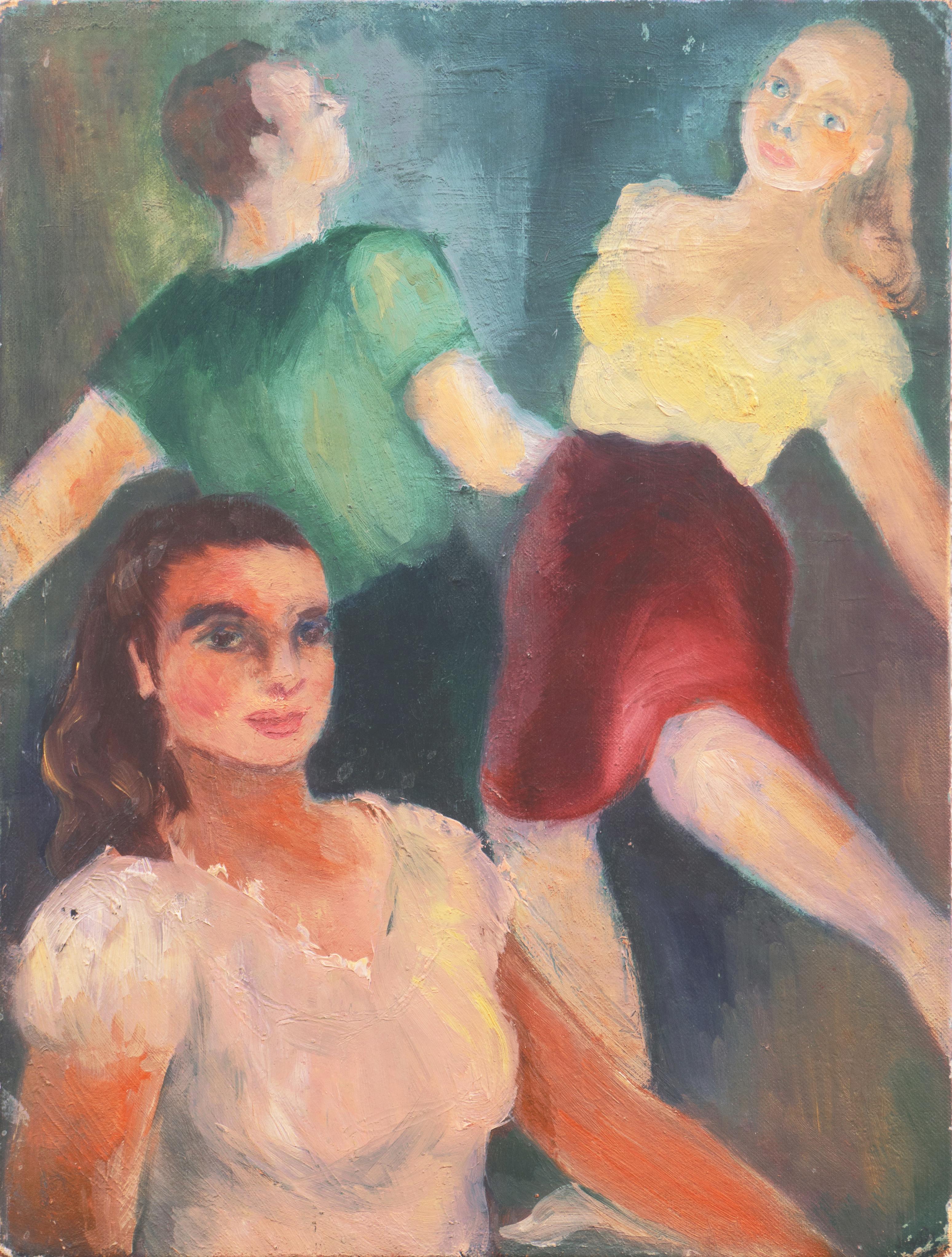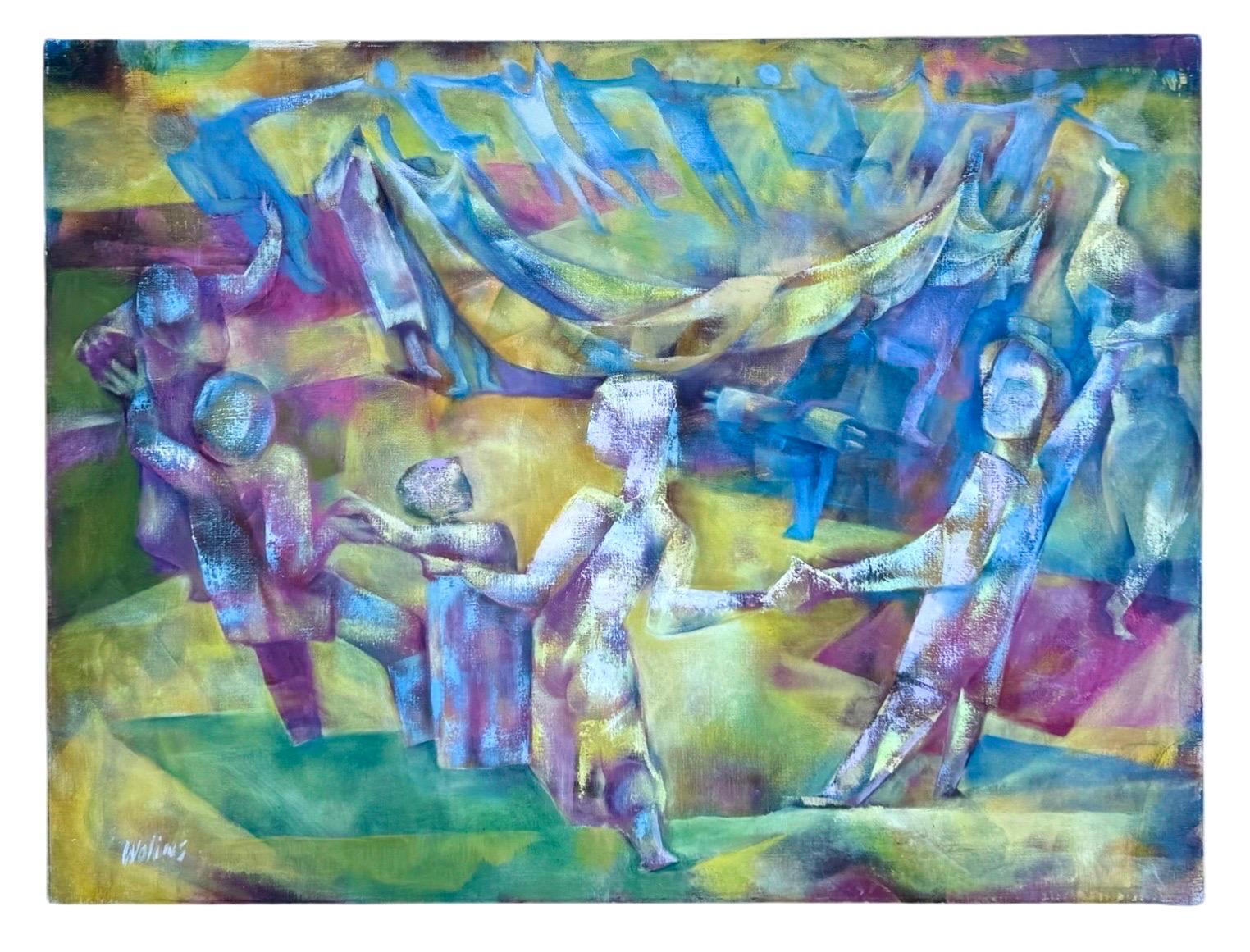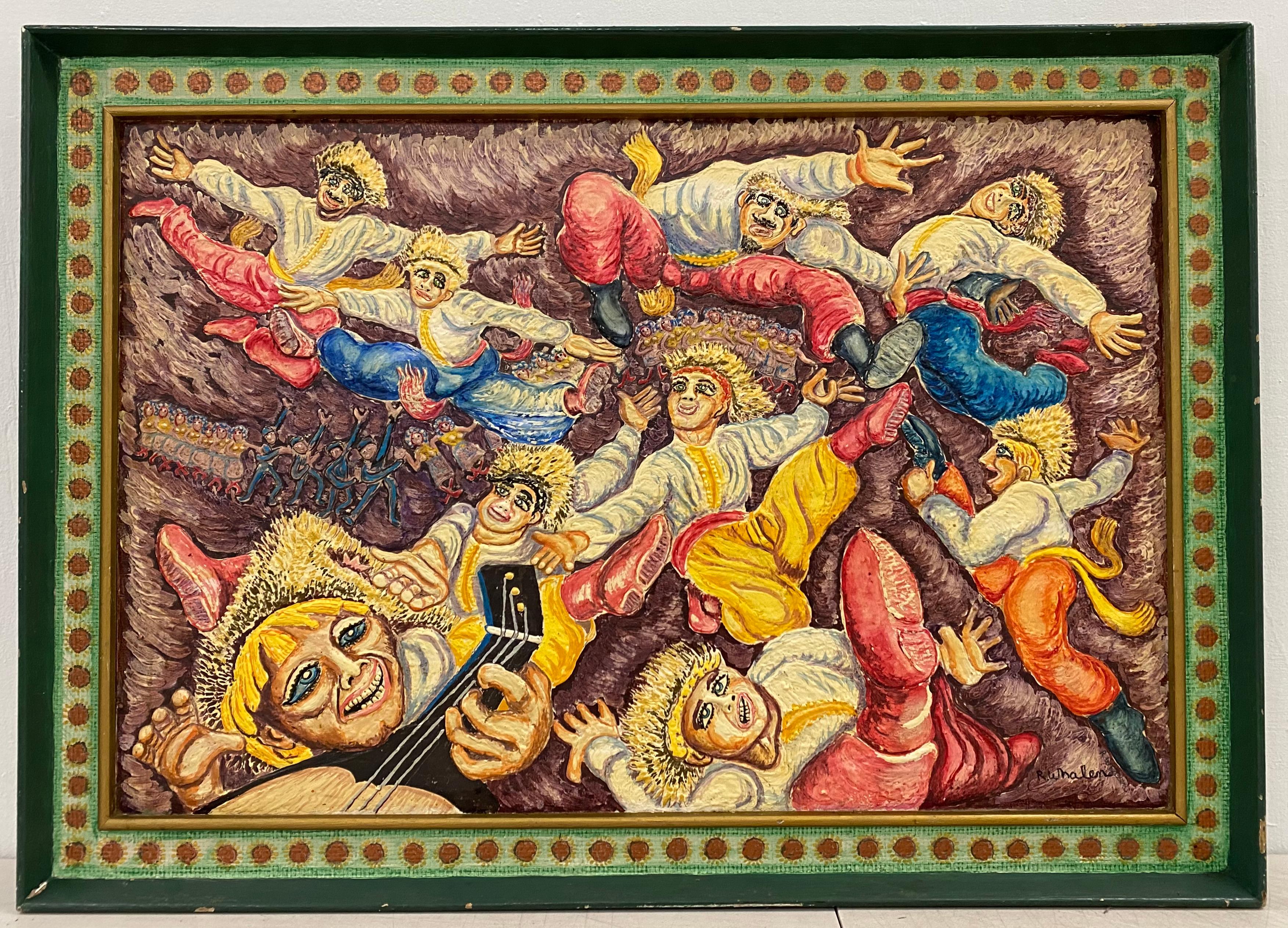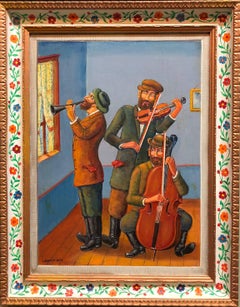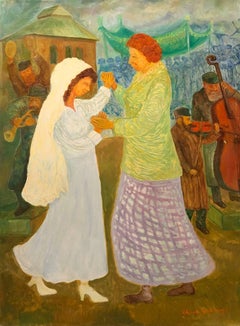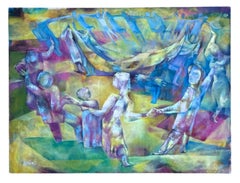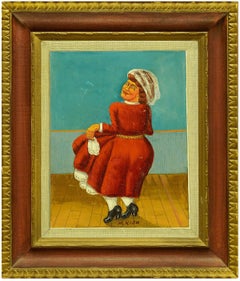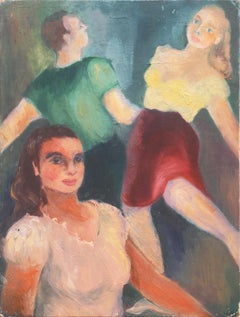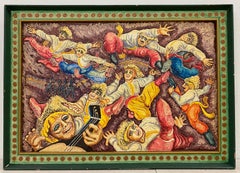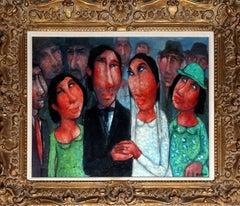Items Similar to Dance of the In laws Wedding Scene Judaica Shtetl Oil Painting WPA Jewish Artist
Want more images or videos?
Request additional images or videos from the seller
1 of 9
Maurice KishDance of the In laws Wedding Scene Judaica Shtetl Oil Painting WPA Jewish Artist
$4,000
£3,035.11
€3,470.37
CA$5,586.92
A$6,211.89
CHF 3,243.51
MX$75,613.82
NOK 41,385.72
SEK 38,776.45
DKK 25,900.04
Shipping
Retrieving quote...The 1stDibs Promise:
Authenticity Guarantee,
Money-Back Guarantee,
24-Hour Cancellation
About the Item
Genre: Modern
Subject: Jewish Wedding Mechutanim
Medium: Oil
Surface: Board, size includes artist decorated frame
Country: United States
The imagery of Maurice Kish (1895-1987), whether factories or carousels, reliably subverts expectations. His vision hovers just around the unraveling edge of things, where what is solid and clear becomes ambiguous. He is fascinated, often delighted, by the falling apart. This unexpected, fresh perspective results in oddly affecting pictures of a now long-gone New York.
Born Moishe in a town called Dvinsk, Russia (what is now Daugavpils, Latvia), Kish came with his family to New York when he was in his teens. The family settled in Brownsville, and for the rest of Kish’s life Brooklyn remained his home, though he moved from one neighborhood to another. He was close to his parents, who recognized his talent and supported his desire to become an artist.
Kish attended the National Academy of Design as well as Cooper Union. His fellow students included many other immigrants and children of immigrants who were particularly receptive to the Modernism coming from Europe. As his career progressed, Kish himself applied different strains of Modernism to different purposes. For him, the story was held above all else.
For years, Kish used the skills he acquired in art school to earn his living at a Manhattan glass factory where he painted floral designs on vases. During the Depression, Kish became a WPA painter in the Federal Art Project (FAP). FAP artists were given a mandate to create works that celebrated labor. The artists tended to be socially progressive, as Kish certainly was. Kish's work from this period, with its dark colors and rolling clouds, reveals the influence of Social Realists like Thomas Hart Benton. Apparent, too, is Kish's interest in the urban monumentality of Charles Sheeler. Kish's structures, however, lack Sheeler's almost dehumanized precision. Rather than the soulless, sleek machines of a typical modern urban dystopia, Kish's factories are shaggy old beasts as worn out as the laborers who troop through their doors. In End of Day's Toil, now at the Smithsonian, the viewer feels some affection for that rambly grandfather of a building all the tired small workers are leaving behind.
Much of Kish's work, for the FAP and elsewhere, undermines received truths in a similar way. Some early works with themes from Yiddish culture are overtly humorous: a painting of a big jolly wedding guest, looking invitingly over her shoulder; a big fiddler on a small roof. Later, the humor becomes more ironic and reflective. In another work, the rather imposing organ grinder of the late 1930s looms above a child, yet his intermediary the cockatoo is bright and appealing, and offers the girl a fortune with his beak. This could read as an allegory for capitalism as easily as a straightforward colorful street scene. A small painting of a snowy day in Washington Square gives a bird's eye view of people bent against the wind walking alone or in pairs. The huge triumphal arch at the middle of it has no connection to their movements or their lives. Kish makes its size and centrality a quiet joke about the futility of grandiose gestures. Like the buildings in his FAP works, the arch has a personality. It is a landmark that looks a bit lost.
A favorite location for Kish was Coney Island. For the laborers of the city, this was a place of great freedom and possibility. There were no bosses! Anyone could go to ride the rides and swim in the sea. For Kish, Coney Island, and especially Luna Park, became a place richly symbolic of workers’ rights. For the dreamlike paintings he set there, Kish looked past the Social Realists to the Expressionists. His colors are brilliant and his lines are wild. These images, joyfully unrestrained, give full voice to an anarchic vision merely hinted at in other works. If the structures of the earlier pictures came further out of the background than expected, these Coney Island structures completely take over the scene.
Kish made several variations on the theme of the carousel as a site of revolution. In the moonlight, the horses have broken from their poles and spin away from the calm center. The workers have come to manic life, have released themselves from the yoke of labor and have abandoned their master, the merry-go-round. They escape to different corners of the pleasure park, dance together and ride the ferris wheel. One horse pretends to be a ticket seller. It is another allegory, one that depicts a worker's holiday paradise in carnival fashion.
A painter who embraced ambiguity, Kish was himself a man who occupied many worlds simultaneously. Even during the period when he had shows at prestigious galleries and belonged to several artists' groups, he identified most strongly as an outsider, a Yiddischer. He wrote poetry in Yiddish throughout his life. In 1968, he published a volume of fifty years of these poems, Di Velt ist Mayn Lid (The World is My Song) in Yiddish, with no English translation, for his peers. Kish also translated English-language poetry into Yiddish and acted as a guide to help other Yiddish writers. Long after the art organizations ceased to provide meaning and fulfillment, Kish was a devoted member of the Yiddish Culture Association.
In addition to painting and poetry, Kish was a dancer who taught during the summers at various Jewish resorts in the Catskills. Small but lithe, he also spent some years as an amateur boxer. Well into his eighties, Kish was proud of the quality of his handball game.
By the 1940s, Kish’s career was going well, but his descriptive style of working began to fall out of fashion, supplanted by a more formal Abstraction. Kish was never able to support himself solely through his art, yet in the midst of all of his other activities, Kish continued to create his distinctive images of an immigrant's New York. He departed far from the mainstream, and in later years, seldom showed his work, preferring to keep it for himself (although he sometimes traded paintings for rent).
Of making art, Kish said, "It is a sacred mission to enrich, to elevate and to make our lives more complete." His works, though frequently playful, encourage a second look at ordinary things. His irreverence elevates by revealing flaws where his audience, all workers and outsiders of a kind, can get a purchase. Kish's art fondly celebrates the beauty of the irregular.
- Creator:Maurice Kish (1895-1987, American)
- Dimensions:Height: 17.5 in (44.45 cm)Width: 21 in (53.34 cm)
- Medium:
- Movement & Style:
- Period:
- Condition:minor wear.
- Gallery Location:Surfside, FL
- Reference Number:1stDibs: LU38213152432
About the Seller
4.9
Platinum Seller
Premium sellers with a 4.7+ rating and 24-hour response times
Established in 1995
1stDibs seller since 2014
1,784 sales on 1stDibs
Typical response time: <1 hour
- ShippingRetrieving quote...Shipping from: Surfside, FL
- Return Policy
Authenticity Guarantee
In the unlikely event there’s an issue with an item’s authenticity, contact us within 1 year for a full refund. DetailsMoney-Back Guarantee
If your item is not as described, is damaged in transit, or does not arrive, contact us within 7 days for a full refund. Details24-Hour Cancellation
You have a 24-hour grace period in which to reconsider your purchase, with no questions asked.Vetted Professional Sellers
Our world-class sellers must adhere to strict standards for service and quality, maintaining the integrity of our listings.Price-Match Guarantee
If you find that a seller listed the same item for a lower price elsewhere, we’ll match it.Trusted Global Delivery
Our best-in-class carrier network provides specialized shipping options worldwide, including custom delivery.More From This Seller
View AllThree Klezmer Musicians Modern Judaica Shtetl Oil Painting WPA Jewish artist
By Maurice Kish
Located in Surfside, FL
Genre: Modern
Subject: Klezmer Musicians
Medium: Oil
Surface: Board, size includes artist decorated frame without frame 16X12
Country: United States
The imagery of Maurice Kish (189...
Category
Mid-20th Century Modern Figurative Paintings
Materials
Oil
Mother Daughter Wedding Dance, Large Judaica Oil Painting, Shtetl Life
By Chaïm Goldberg
Located in Surfside, FL
Genre: Judaica
Subject: People
Medium: Oil
Surface: Canvas
Country: United States
Dimensions: 40" x 30 1/4"
Chaim Goldberg -- born in the Polish shtetl of Kazimierz Dolny
Chaim Gol...
Category
20th Century Impressionist Figurative Paintings
Materials
Canvas, Oil
Joseph Wolins WPA Artist Dancing, Torah Modernist Judaica Cubist Oil Painting
By Joseph Wolins
Located in Surfside, FL
Joseph Wolins 1915-1999
Subject: Jewish, Dancing with the Torah (New Torah, Simchat Torah)
Hand signed oil painting
In this painting, Joseph Wolins uses vibrant and complimentary co...
Category
20th Century American Modern Figurative Paintings
Materials
Canvas, Oil
The Happy Inlaw, Oil Painting
By Maurice Kish
Located in Surfside, FL
The imagery of Maurice Kish (1895-1987), whether factories or carousels, reliably subverts expectations. His vision hovers just around the unraveling edge of things, where what is solid and clear becomes ambiguous. He is fascinated, often delighted, by the falling apart. This unexpected, fresh perspective results in oddly affecting pictures of a now long-gone New York.
Born Moishe in a town called Dvinsk, Russia (what is now Daugavpils, Latvia), Kish came with his family to New York when he was in his teens. The family settled in Brownsville, and for the rest of Kish’s life Brooklyn remained his home, though he moved from one neighborhood to another. He was close to his parents, who recognized his talent and supported his desire to become an artist.
Kish attended the National Academy of Design as well as Cooper Union. His fellow students included many other immigrants and children of immigrants who were particularly receptive to the Modernism coming from Europe. As his career progressed, Kish himself applied different strains of Modernism to different purposes. For him, the story was held above all else.
For years, Kish used the skills he acquired in art school to earn his living at a Manhattan glass...
Category
20th Century Folk Art Figurative Paintings
Materials
Oil, Board
Whimsical Judaica Shtetl Shadchan Matchmaker Oil Painting WPA Jewish Folk Artist
By Maurice Kish
Located in Surfside, FL
Genre: Modern
Subject: Fiddler on the roof, Shtetl matchmaker
Medium: Oil
Surface: Board, size includes artist decorated frame
Country: United States
The imagery of Maurice Kish (18...
Category
Mid-20th Century Folk Art Figurative Paintings
Materials
Oil, Board
Colorful Russian French Judaica Jewish Shtetl Wedding Lithograph Mourlot Paris
By Mane Katz
Located in Surfside, FL
Mane-Katz (1894-1962) Original Lithograph published by Andre Sauret, Monte Carlo, 1966, printed in France, by Mourlot. The ouvrage sheet is not included. this is from a limited editi...
Category
1960s Modern Figurative Prints
Materials
Lithograph
You May Also Like
'Couple Dancing', American Folk Art Figural Oil, WPA era
Located in Santa Cruz, CA
Signed indistinctly, lower right, and painted circa 1935.
A strongly animated, vertically stacked figurative painting filled with compressed energy and an atmosphere of psychologic...
Category
1940s Figurative Paintings
Materials
Oil, Board
Richard Whalen "Ukrainian Dancers" Original Oil Painting c.1990
By Richard Whalen
Located in San Francisco, CA
Richard Whalen (American, 1926-2009)
"Ukrainian Dancers" Original Oil Painting c.1990
Created on a wooden panel and housed in a handmade custom frame...
Category
Late 20th Century Figurative Paintings
Materials
Plywood, Oil
"The Marriage Proposal (Family Gathering), " Leo Schutzman, Jewish Folk Art
By Leo Schutzman
Located in New York, NY
Leo Schutzman (1878 - 1962)
The Marriage Proposal, circa 1958
Oil on canvas
24 x 20 inches
Signed lower left
Leo (Kyle) Schutzman (1878-1962) developed ...
Category
1950s Folk Art Figurative Paintings
Materials
Canvas, Oil
Wedding, Oil Painting by Rene Cazassus
Located in Long Island City, NY
A colorful folk marriage scene by French artist, Rene Cazassus. The painting is signed lower right and beautifully framed.
Category
Late 20th Century Folk Art Figurative Paintings
Materials
Oil
Wedding Dance, Signed Acrylic on Paper by Jovan Obican
By Jovan Obican
Located in Long Island City, NY
Wedding Dance
Jovan Obican
French/Yugoslavian (1918–1986)
Date: circa 1970
Acrylic on Paper, signed l.l.
Size: 24.5 x 19 in. (62.23 x 48.26 cm)
Frame Size: 29 x 23 inches
Category
1970s Folk Art Paintings
Materials
Acrylic
Wedding Dance I, Signed Acrylic on Paper by Jovan Obican
By Jovan Obican
Located in Long Island City, NY
Wedding Dance I
Jovan Obican
French/Yugoslavian (1918–1986)
Date: circa 1975
Acrylic on Paper, signed l.r.
Size: 17 in. x 26 in. (43.18 cm x 66.04 cm)
Frame Size: 23 x 32 inches
Category
1970s Folk Art Paintings
Materials
Acrylic
More Ways To Browse
For Rent
Wedding Painting
Wedding In Paintings
Jewish Russian Painting
Judaica Artist
Children In The Park Painting
Jewish Mid Century Art
Oil Paintings Of Central Park
Modern Judaica Painting
Dancing Girl Painting
Vintage Spin Art
Vintage Manhattan Glass
Catskills Painting
Wpa Styled Oil Paintings
Vintage Machine Oiler
Girl Horse Painting
Oil Paintings Of Jewish Man
Dark Floral Oil Painting
